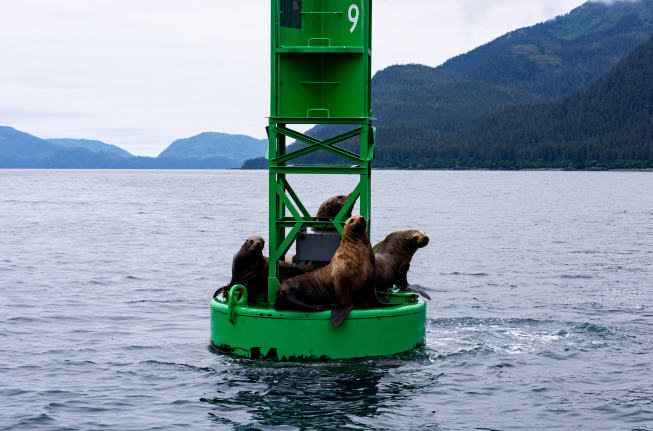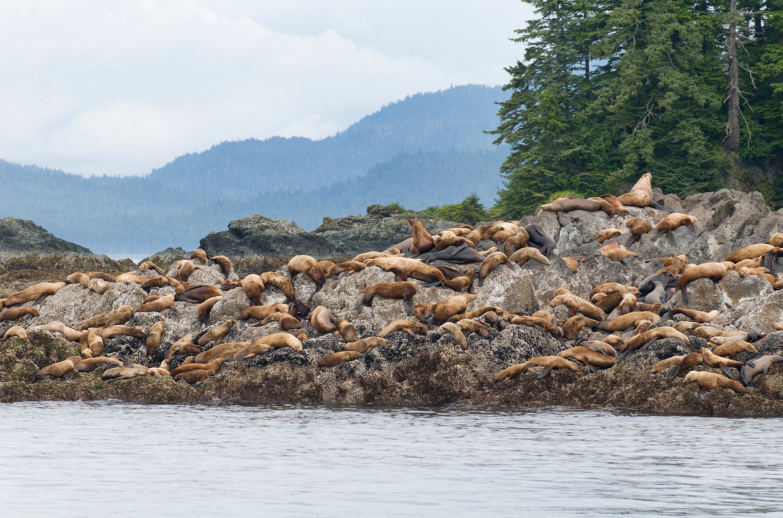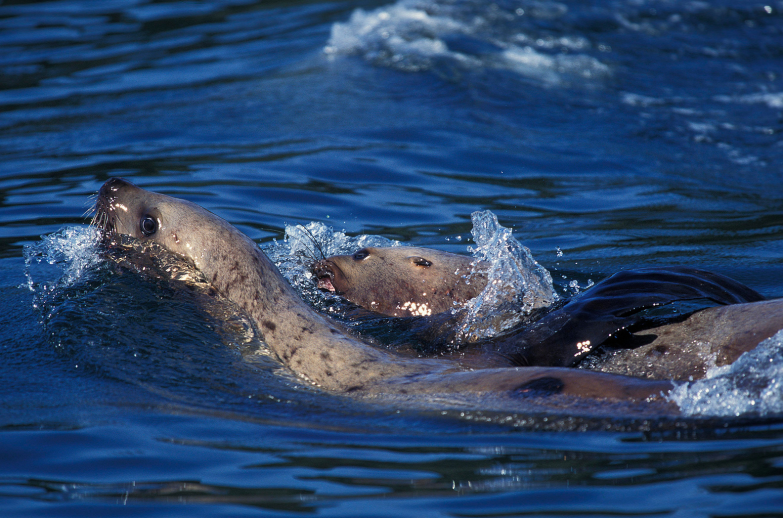If harbor seals are the quiet watchers of Southeast Alaska’s coastline, Steller sea lions are their louder, larger, and more animated cousins. Whether they’re barking loudly from a rocky haul-out, splashing in the water near your boat, or jostling for space in their boisterous colonies, these powerful marine mammals are impossible to miss.
On our Ketchikan Wildlife Tours, Steller sea lions are a guest favorite — not just because of their size and presence, but because they reveal so much about Alaska’s rugged marine ecosystem. In this post, we’re diving into everything you need to know about Steller sea lions: their biology, behavior, cultural significance, threats, and what makes them such a memorable part of the Southeast Alaska experience.
What Are Steller Sea Lions?
Steller sea lions (Eumetopias jubatus) are the largest species of sea lion in the world and one of the most striking marine mammals you’ll encounter in Alaska. Named after German naturalist Georg Wilhelm Steller, who first described them in 1741, they are found along the North Pacific from Russia and Japan to British Columbia and California — but their stronghold is right here in Southeast Alaska.
Unlike true seals, Steller sea lions have:
External ear flaps
Large, strong front flippers they use to “walk” on land
Vocal cords that allow them to make their signature barking sounds
They are members of the “eared seal” family (Otariidae), which also includes California sea lions and fur seals.
Quick Facts About Steller Sea Lions
Scientific Name: Eumetopias jubatus
Common Name: Steller Sea Lion
Size:
Males can weigh over 2,000 pounds and reach 11 feet in length. Females are smaller, typically around 600–800 pounds.
Diet:
Steller sea lions are opportunistic predators, feeding on fish (like herring, pollock, salmon, and cod), squid, and octopus. They can dive up to 1,500 feet and stay underwater for several minutes while foraging.
Lifespan:
They can live 20–30 years in the wild, though males often have shorter lifespans due to the stress and competition of breeding.
Behavior:
Highly social and vocal, they form raucous colonies on rocky islands and beaches, especially during breeding season. Males establish harems of females, fiercely defending their territory with loud roars and physical posturing.
Where to See Them:
In Ketchikan and surrounding waters, look for Steller sea lions on rocky outcrops, sea stacks, and remote beaches. They’re often seen lounging in groups or swimming near schools of fish.

Why Steller Sea Lions Matter to Ketchikan
As top predators, Steller sea lions play a critical role in maintaining a balanced marine ecosystem. Their presence helps regulate fish populations and indicates ocean health. But their importance extends far beyond the food chain.
Steller Sea Lions in Alaska Indigenous Culture
Long before Alaska became a tourist destination, Steller sea lions held — and still hold — deep significance for the Tlingit, Haida, and Tsimshian peoples, the Indigenous communities of Southeast Alaska. These marine giants were not only vital sources of food and materials but also held an esteemed place in spiritual and clan traditions.
Traditional Uses:
Meat and Oil: Sea lion meat provided valuable protein during the long winters, and the oil was used for cooking, heating, and preservation.
Skins: Their thick hides were fashioned into waterproof garments, drums, and covering for boats (baidarkas), showcasing both craftsmanship and resourcefulness.
Whiskers and Bones: Even smaller parts of the sea lion, like whiskers and bones, were used in art, regalia, or tools.
Every part of the animal was respected and used with care. Furthermore, this reflects a deep-rooted ethic of sustainability and reciprocity with the natural world.
Spiritual and Symbolic Roles:
In oral histories and clan stories, Steller sea lions are often portrayed as intelligent, powerful, and protective beings. They may appear as:
Shapeshifters or guardians from the sea
Clan crests or totem figures, symbolizing strength, leadership, and connection to ocean life
Mediators between the human and animal worlds, bridging realms of spirit, survival, and story
Some families even trace ancestral ties to sea lions through mythical transformations, where a human marries or becomes a sea lion. This is a recurring theme in coastal Native storytelling that reflects deep interconnectedness between people and the marine world.
Today, many Indigenous communities in Southeast Alaska continue to maintain their relationship with sea lions. This happens through traditional practices, cultural education, and advocacy for ocean conservation. For visitors, learning about this connection adds depth and meaning to every wildlife encounter.

Fun and Fascinating Facts About Steller Sea Lions
They’re louder than a rock concert. A colony in full voice can be heard from over a mile away!
Males develop a thick “mane” of fur around their neck, giving them a lion-like appearance — hence the name.
Sea lion pups are born in June or July, and mothers nurse them for up to a year.
Steller sea lions can rotate their rear flippers forward, allowing them to walk on land much more effectively than seals.
They often porpoise through the water, leaping in and out as they swim — a behavior that’s both efficient and fun to watch.
Threats to Steller Sea Lions — And Conservation Efforts
Steller sea lions have faced significant challenges over the past few decades. While populations in the eastern range (like Southeast AK) are considered stable, those in the western Gulf of Alaska have experienced dramatic declines. This in turn, has triggered endangered species protections.
Primary Threats:
Overfishing: Reduces availability of key prey species like pollock and herring
Climate Change: Alters ocean temperatures and currents, impacting food sources
Entanglement: Fishing gear and marine debris pose ongoing threats
Disturbance from Humans: Increased marine traffic and tourism can disrupt breeding and resting areas
Conservation Highlights:
Steller sea lions are protected under the Marine Mammal Protection Act (MMPA)
They are listed under the Endangered Species Act (ESA) in parts of their range
NOAA Fisheries closely monitors populations, health, and habitat conditions
Responsible eco-tourism promotes awareness and respect, helping guests understand how to safely view sea lions without disrupting them
Why You Shouldn't Miss Them on Your Ketchikan Wildlife Tour
Steller sea lions offer something truly unique: a raw, powerful glimpse into Alaska’s marine wilderness. Their sheer size, volume, and energy are unforgettable — especially when seen up close in their natural habitat.
Whether you’re photographing wildlife or simply enjoying the ride, a close encounter with Steller sea lions is guaranteed to be a highlight of your trip.
Ready to Meet the Giants of the Sea?
Book one of our Ketchikan Wildlife Tours and see Steller sea lions in their element — wild, loud, and larger-than-life. Alongside harbor seals, whales, bald eagles, and more, they make up the unforgettable cast of characters that define Southeast Alaska.

